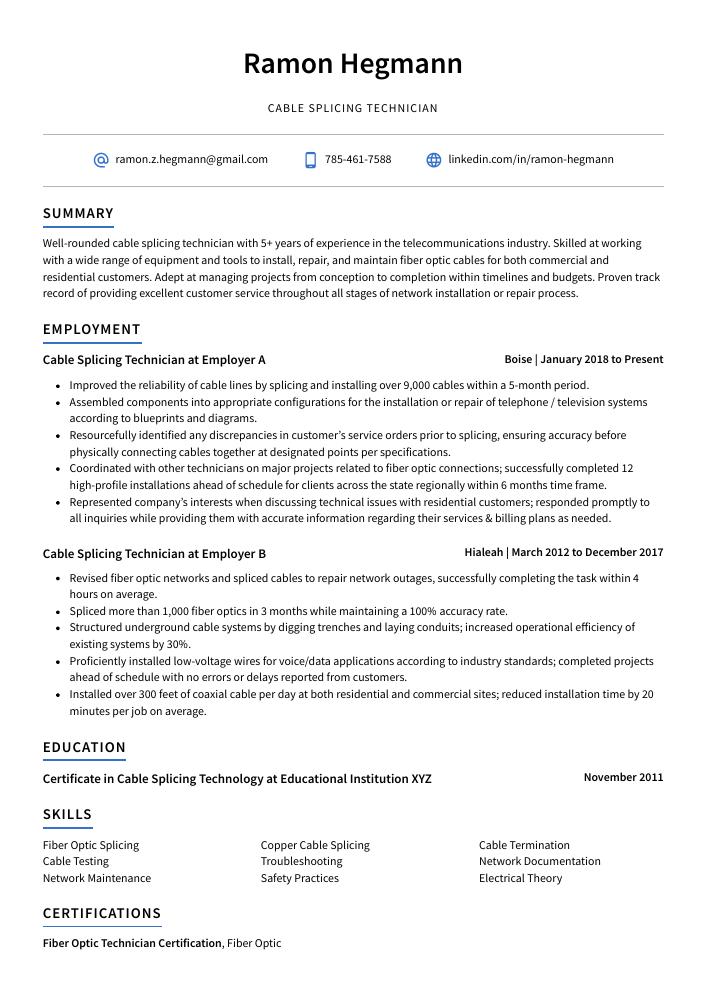Cable Splicing Technician Resume Guide
Cable splicing technicians install, maintain, and repair communication cables. They use specialized tools to cut, strip, and splice wires in order to connect them with the necessary equipment for proper functioning. Additionally, they inspect existing systems for damage or malfunctions that need attention before making repairs as needed.
Your skill in cable splicing and network installation is unrivaled, but hiring managers don’t know who you are. To make them aware of your accomplishments, create a resume that stands out from the crowd and shows off your expertise.
This guide will walk you through the entire process of creating a top-notch resume. We first show you a complete example and then break down what each resume section should look like.
Table of Contents
The guide is divided into sections for your convenience. You can read it from beginning to end or use the table of contents below to jump to a specific part.
Cable Splicing Technician Resume Sample
Ramon Hegmann
Cable Splicing Technician
[email protected]
785-461-7588
linkedin.com/in/ramon-hegmann
Summary
Well-rounded cable splicing technician with 5+ years of experience in the telecommunications industry. Skilled at working with a wide range of equipment and tools to install, repair, and maintain fiber optic cables for both commercial and residential customers. Adept at managing projects from conception to completion within timelines and budgets. Proven track record of providing excellent customer service throughout all stages of network installation or repair process.
Experience
Cable Splicing Technician, Employer A
Boise, Jan 2018 – Present
- Improved the reliability of cable lines by splicing and installing over 9,000 cables within a 5-month period.
- Assembled components into appropriate configurations for the installation or repair of telephone / television systems according to blueprints and diagrams.
- Resourcefully identified any discrepancies in customer’s service orders prior to splicing, ensuring accuracy before physically connecting cables together at designated points per specifications.
- Coordinated with other technicians on major projects related to fiber optic connections; successfully completed 12 high-profile installations ahead of schedule for clients across the state regionally within 6 months time frame.
- Represented company’s interests when discussing technical issues with residential customers; responded promptly to all inquiries while providing them with accurate information regarding their services & billing plans as needed.
Cable Splicing Technician, Employer B
Hialeah, Mar 2012 – Dec 2017
- Revised fiber optic networks and spliced cables to repair network outages, successfully completing the task within 4 hours on average.
- Spliced more than 1,000 fiber optics in 3 months while maintaining a 100% accuracy rate.
- Structured underground cable systems by digging trenches and laying conduits; increased operational efficiency of existing systems by 30%.
- Proficiently installed low-voltage wires for voice/data applications according to industry standards; completed projects ahead of schedule with no errors or delays reported from customers.
- Installed over 300 feet of coaxial cable per day at both residential and commercial sites; reduced installation time by 20 minutes per job on average.
Skills
- Fiber Optic Splicing
- Copper Cable Splicing
- Cable Termination
- Cable Testing
- Troubleshooting
- Network Documentation
- Network Maintenance
- Safety Practices
- Electrical Theory
Education
Certificate in Cable Splicing Technology
Educational Institution XYZ
Nov 2011
Certifications
Fiber Optic Technician Certification
Fiber Optic Association
May 2017
1. Summary / Objective
Your resume summary should be a brief but compelling introduction to your professional experience and qualifications as a cable splicing technician. Include the most important details about yourself, such as the number of years you have been in this field, any certifications or special training you may have received, and how many miles of cables you are able to install each day. Showcase your expertise with fiber optics technology and mention any awards or recognition that demonstrate your commitment to excellence.
Below are some resume summary examples:
Energetic and reliable cable splicing technician with 10+ years of experience in telecommunications industry. Deep understanding of different types and configurations of fiber optic cables, optical splitters, coaxial cables, and their associated hardware. Successfully completed over 200 projects on time and within budget while ensuring quality control standards are met. Looking to join ABC’s team for a challenging role as an experienced Cable Splicing Technician.
Passionate and experienced cable splicing technician with 5+ years of experience in the telecommunications industry. Seeking to leverage my expertise and attention to detail at XYZ Communications. At ABC, I was responsible for setting up fiber optic networks and installing copper cables on both residential and commercial projects. Received numerous awards for safety practices while successfully completing over 100 customer locations without incident or injury.
Enthusiastic and hardworking cable splicing technician with 8+ years of experience in the telecommunications industry. Highly knowledgeable in fiber optics and copper wiring installation, maintenance, troubleshooting and repair. Achieved a 97% success rate for all projects completed on-time and within budget at XYZ Corp. Looking to join ABC Tech as a Cable Splicing Technician where I can utilize my expertise to maintain high network performance standards.
Determined cable splicing technician with 8+ years of experience in the telecom industry. Expertise in fiber optics, coaxial cable and copper telephone line installation and repair. Skilled at working independently or as part of a team to ensure timely project completion while adhering to safety standards and customer satisfaction guidelines. Recognized for achieving cost savings on projects through efficient use of time and materials management.
Reliable and detail-oriented cable splicing technician with 8+ years of experience in the telecommunications industry. Demonstrated expertise in fiber optic, copper and coaxial cables installation. At XYZ Technologies, identified an unknown fault which resulted in a 20% improvement on productivity. Seeking to join ABC Tech as a Splicing Technician to help drive customer satisfaction through excellent workmanship and technical know-how.
Amicable Cable Splicing Technician with 5+ years of experience in the telecommunications industry. Skilled at installing, splicing, maintaining and repairing copper and fiber optic cables for various clients across multiple locations. Dedicated to keeping up-to-date with advancements in technology while delivering a high level of customer service satisfaction. Looking to join ABC Telecom as part of their team of professionals.
Talented and experienced Cable Splicing Technician with 10+ years of experience in the telecommunications industry. Skilled at installing, splicing, and testing copper and fiber optic cables. At XYZ Communications Inc., successfully completed over 200 projects while meeting safety protocols and deadlines. Looking to join ABC Telecom as a Cable Splicer to help expand their services across North America.
Driven cable splicing technician with 5+ years of experience. Installed, maintained and repaired voice/data telecommunications systems for large-scale projects across the country. Certified in fiber optics & Splicing by XYZ Company. Received 3 awards from ABC Corporation for excellence in customer service, safety standards adherence and on-time completion of complex jobs within budget constraints.
2. Experience / Employment
In the experience section, you should list your employment history in reverse chronological order. This means that the most recent job is listed first.
Stick to bullet points when writing this section; it makes it easier for the reader to take in what you are saying quickly and easily. When talking about what you did on each role, provide detail and quantify any results achieved where possible.
For example, instead of saying “Installed cables,” say something like “Successfully installed 1km of fiber optic cable between two buildings within a 2-day period.”
To write effective bullet points, begin with a strong verb or adverb. Industry specific verbs to use are:
- Installed
- Connected
- Spliced
- Tested
- Troubleshot
- Inspected
- Repaired
- Terminated
- Measured
- Sealed
- Grounded
- Soldered
- Assembled
- Configured
Other general verbs you can use are:
- Achieved
- Advised
- Assessed
- Compiled
- Coordinated
- Demonstrated
- Developed
- Expedited
- Facilitated
- Formulated
- Improved
- Introduced
- Mentored
- Optimized
- Participated
- Prepared
- Presented
- Reduced
- Reorganized
- Represented
- Revised
- Spearheaded
- Streamlined
- Structured
- Utilized
Below are some example bullet points:
- Demonstrated extensive knowledge of telecommunications cabling systems and splice techniques to install over 24,000 feet of coax cable while successfully increasing connectivity rate by 10%.
- Inspected existing materials, tools and equipment for any damages or missing parts; replaced defective items with new ones within budget guidelines.
- Diligently followed safety standards when operating heavy machinery during the process of trenching cables, which helped minimize workplace accidents by 15%.
- Reorganized inventory system according to company regulations; reduced expenses from unnecessary purchasing requests by 30% in 1 year’s time frame.
- Utilized specialized testing instruments to ensure that all connected cables were functioning correctly prior to job completion; monitored and adjusted signal levels as necessary without fail each week.
- Formulated plans and strategies to successfully install, splice and maintain fiber optic cables for over 400+ residences in the past year; increased installation efficiency by 10%.
- Successfully tested, troubleshot and repaired cable connections for 300+ customers each month; reduced repair time per connection by 20 minutes on average.
- Mentored junior technicians in correct cable splicing procedures as well as safety regulations & protocols to ensure quality of work was maintained at all times; improved team performance by 25%.
- Expedited installation process through creative use of tools such as wire strippers, cutters & crimpers while ensuring that no damage was done to the cables or surrounding areas.
- Configured specialized equipment according to customer specifications including routers, modems, switches & firewalls with an accuracy rate of 95%+.
- Measured and installed over 1,500 feet of underground cable for residential and commercial customers; successfully completed all projects on time with a 99% accuracy rate.
- Tested fiber-optic cables using specialized electrical equipment to ensure that signals were adequately transmitted between components; saved 40 hours in troubleshooting time due to accurate testing results.
- Accurately spliced coaxial cables while following strict industry safety standards, preventing costly delays or damages from occurring during installations; reduced repair costs by 15%.
- Participated in the training of new technicians on various techniques related to installation and maintenance activities such as stripping wires, soldering connections and grounding systems; increased efficiency amongst team members by 20%.
- Grounded exposed wires per local regulations before completing any work sites; ensured proper bonding was present at each location which minimized electrocution risks for workers and customers alike.
- Competently assessed, spliced and connected underground cable systems for over 50 projects with 100% accuracy.
- Sealed joints using electrical tape and heat shrinkable tubing to ensure water-tight connections; reduced repair costs by 20%.
- Troubleshot existing telecom networks consisting of coaxial cables, optical fibers and power lines in order to identify problems such as broken wire strands or faulty connectors.
- Connected multiple cables together according to customer specifications while adhering strictly to safety regulations at all times; completed complex installations within budget up to 5 days ahead of schedule on average.
- Performed routine maintenance checks on fiber optic cross connects, active equipment racks/cabinets and other telecommunication components used in CATV operations with minimal downtime of just 2 hours per month.
- Facilitated the installation and splicing of over 5,000 miles of fiber optic cables for telecom companies; increased overall productivity by 40%.
- Prepared detailed reports on cable fault locations & repair recommendations in accordance with industry standards; successfully reduced the number of downtime incidents by 25%.
- Achieved an average splice rate of 400 per day while adhering to safety protocols and ensuring quality control throughout the duration of all projects.
- Consistently met deadlines across multiple projects within budget constraints, resulting in a total savings of $25K annually for clients.
- Spearheaded innovative initiatives that improved operational efficiency among team members as well as customer satisfaction levels by 20%.
- Terminated up to 500 fiber optic and coaxial cables per day in a variety of residential, commercial and industrial settings with 100% accuracy.
- Introduced advanced splicing techniques to ensure seamless connections between cable runs; reduced customer complaints by 25%.
- Reliably tested signal strength, transmission quality, line continuity and other parameters post-splicing while adhering to all safety protocols at all times.
- Optimized copper wire infrastructure for major telecommunication companies throughout the state; increased bandwidth capacity by 30%.
- Reduced installation costs for clients through innovative cabling solutions such as aerial placement or underground burying of lines where necessary.
- Advised customers on proper cable splicing options to ensure optimal performance; increased customer satisfaction by 10%.
- Repaired and maintained over 200+ cables, jacks, outlets and routers in a month while meeting all safety regulations; identified and rectified 22 faulty connections resulting in improved network speed by 25%.
- Soldered more than 300 copper wires for various telecom projects within tight deadlines; successfully completed 80% of the assigned tasks with zero defects reported.
- Compiled comprehensive reports detailing service requests fulfilled as well as test results from wire installation works performed; created 15+ detailed case studies for reference purposes that were used to train new technicians.
- Actively monitored progress of cable splicing activities at job sites using specialized tools & equipment such as multimeters, oscilloscopes & signal generators; optimized project completion timescales by 2 days per project on average.
- Efficiently spliced and installed over 1,500 feet of coaxial cables for both residential and commercial properties each week.
- Developed new installation methods that reduced cable splicing time by 25%, resulting in an increase in customer satisfaction ratings by 15%.
- Streamlined the troubleshooting process to more quickly identify faulty connections, saving up to 10 hours a month on repair efforts; overall repair costs were lowered by $1,200 per quarter.
- Presented technical demonstrations at local trade shows regarding industry standards and safety protocols related to cable splicing; increased networking opportunities with potential customers from 5 contacts to 50+.
3. Skills
Skill requirements will differ from employer to employer – this can easily be determined via the job advert. Organization ABC may require experience with copper splicing, while Organization XYZ may need technicians who are knowledgeable in fiber optic cable splicing.
It is essential to keep this in mind because of the applicant tracking systems utilized by many companies. Their role is to analyze resumes for certain characteristics (such as specific keywords), filtering out those they deem not to be a high-quality match for that particular job.
Besides just listing skills here, you should also elaborate on your most important ones in other resume sections such as the summary or work history section.
Below is a list of common skills & terms:
- Cable Pulling Techniques
- Cable Termination
- Cable Testing
- Copper Cable Splicing
- Electrical Theory
- Fiber Optic Splicing
- Network Documentation
- Network Maintenance
- Safety Practices
- Troubleshooting
4. Education
Adding an education section to your resume will depend on how far into your career you are. If you just graduated and have no prior experience, include the education section below your resume objective. However, if you have been working as a cable splicing technician for some time and want to showcase that experience more than anything else, it might be best to omit the education section altogether.
If including an education section is necessary, try to mention courses or subjects related to the specific job duties of a cable splicing technician that may be relevant in order to demonstrate expertise in this field.
Certificate in Cable Splicing Technology
Educational Institution XYZ
Nov 2011
5. Certifications
Certifications demonstrate to potential employers that you have the knowledge and expertise necessary for a given job. They also show that you are committed to staying up-to-date on industry trends, as many certifications require continuing education or recertification every few years.
Including any relevant certifications in your resume can be an effective way of showing off your qualifications and demonstrating why you would make a great candidate for the position.
Fiber Optic Technician Certification
Fiber Optic Association
May 2017
6. Contact Info
Your name should be the first thing a reader sees when viewing your resume, so ensure its positioning is prominent. Your phone number should be written in the most commonly used format in your country/city/state, and your email address should be professional.
You can also choose to include a link to your LinkedIn profile, personal website, or other online platforms relevant to your industry.
Finally, name your resume file appropriately to help hiring managers; for Ramon Hegmann, this would be Ramon-Hegmann-resume.pdf or Ramon-Hegmann-resume.docx.
7. Cover Letter
Cover letters are an essential part of any job application. It’s a formal document that offers additional information about you and your professional experiences, as well as why you’re the best fit for the role.
Most cover letters are made up of 2 to 4 paragraphs and include details such as your background, qualifications, skills and achievements. They should be tailored to each specific employer or company in order to show you’ve done your research on them. Submitting a cover letter is not always required but it could give you an edge over other applicants who don’t bother writing one.
Below is an example cover letter:
Dear Raphael,
I am writing to apply for the position of Cable Splicing Technician at XYZ Company. With more than 10 years of experience in the telecommunications industry, I have the skills and knowledge necessary to be a successful member of your team.
In my current role as a Cable Splicing Technician with ABC Company, I am responsible for installing, repairing, and maintaining cable television and broadband equipment. I have experience working with both residential and commercial customers, and I am confident that I can provide excellent service to your clients. In addition, I have a strong understanding of safety procedures and OSHA standards, which will help me to protect myself and others while on the job.
I believe that my skills and experience make me an ideal candidate for this position, and I look forward to contributing to your company’s success. Thank you for your time and consideration; please do not hesitate to contact me if you have any questions or would like additional information about my qualifications.
Sincerely,
Ramon
Cable Splicing Technician Resume Templates
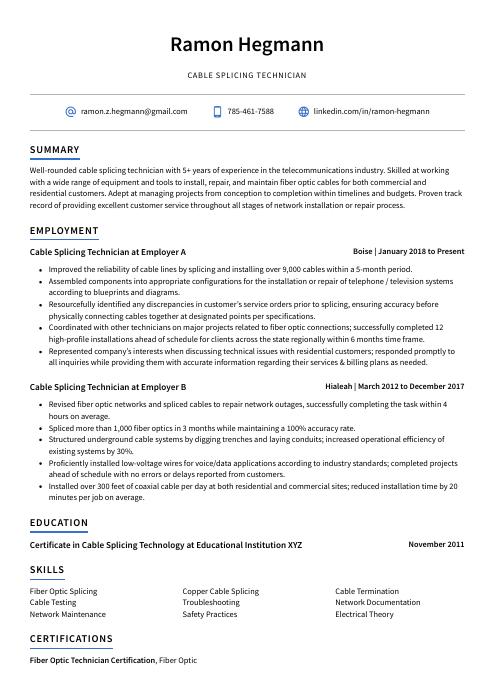 Axolotl
Axolotl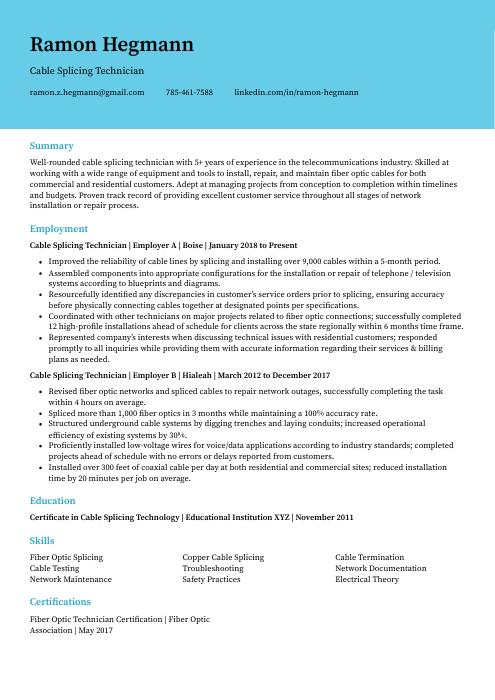 Dugong
Dugong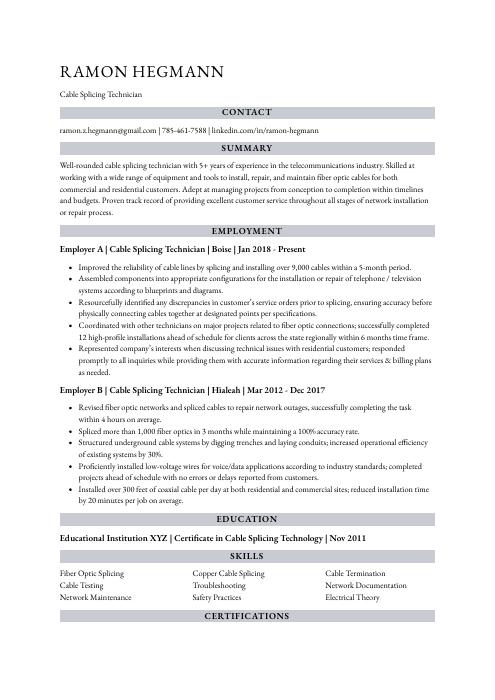 Numbat
Numbat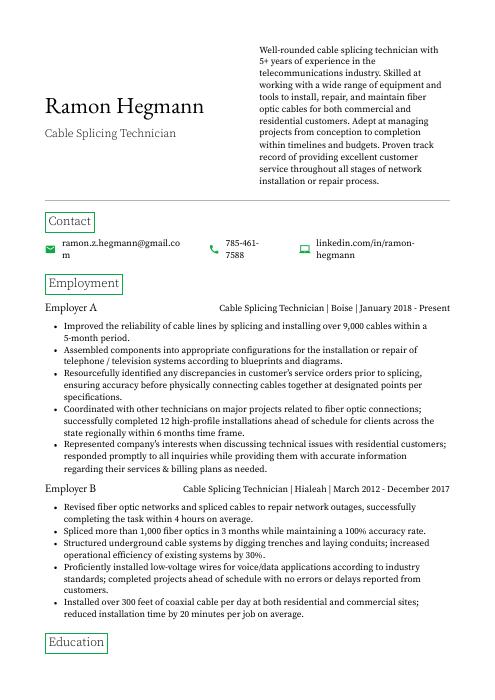 Quokka
Quokka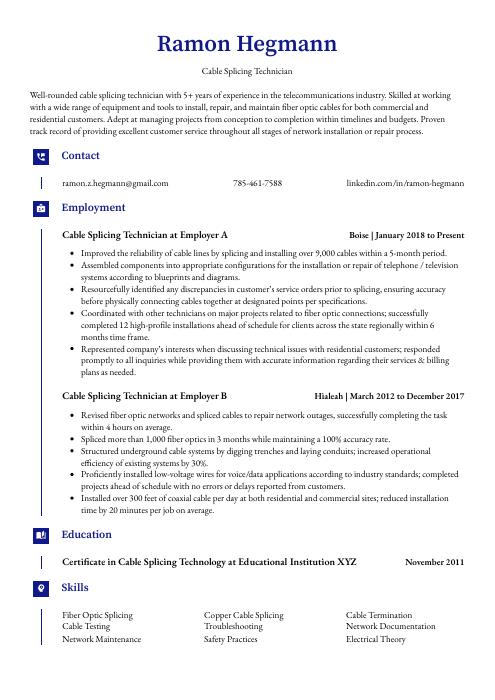 Gharial
Gharial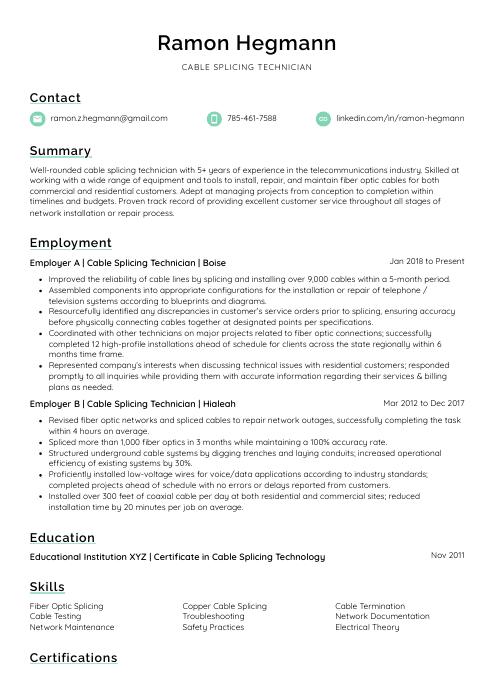 Lorikeet
Lorikeet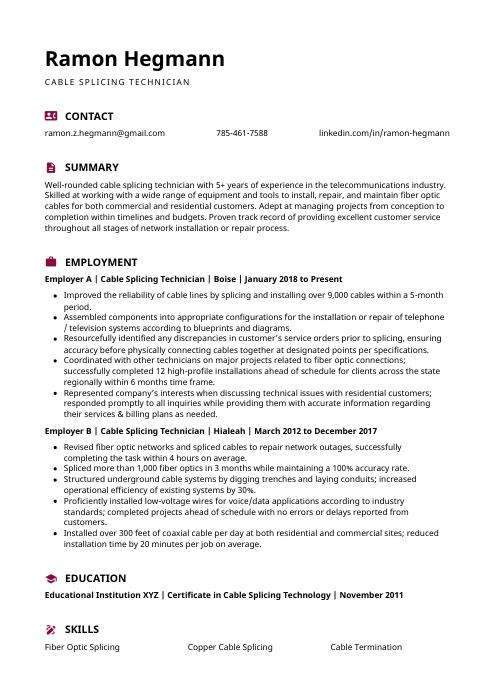 Hoopoe
Hoopoe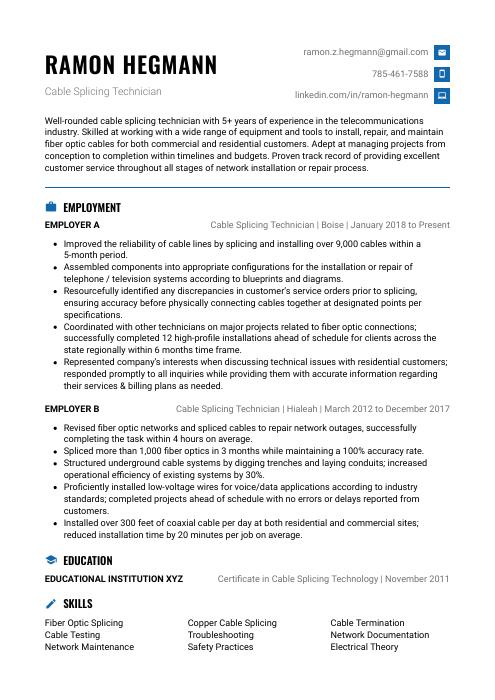 Echidna
Echidna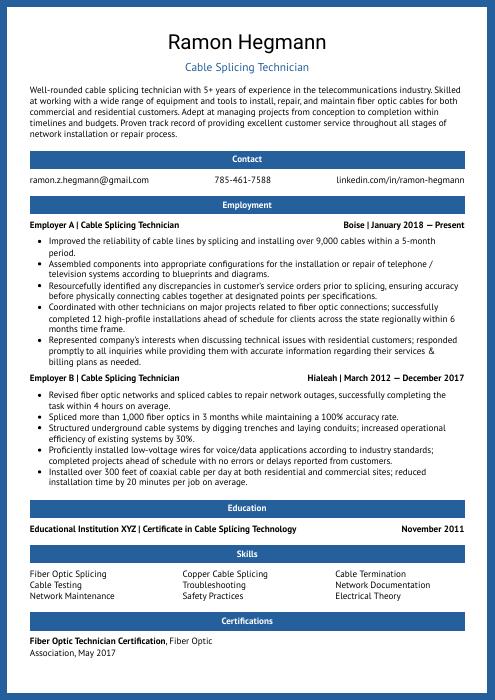 Ocelot
Ocelot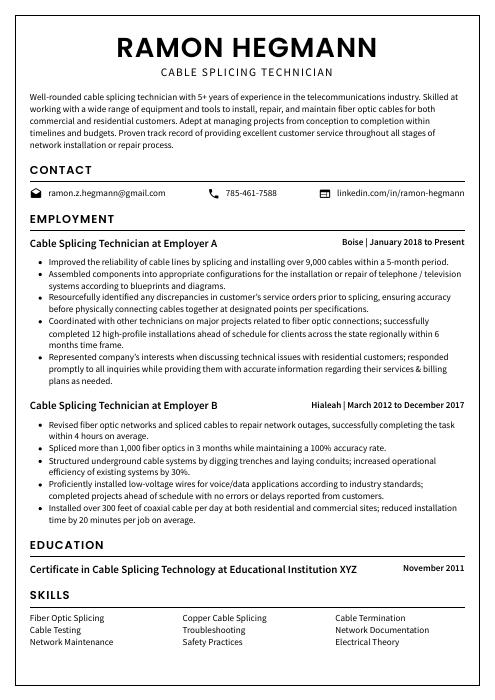 Cormorant
Cormorant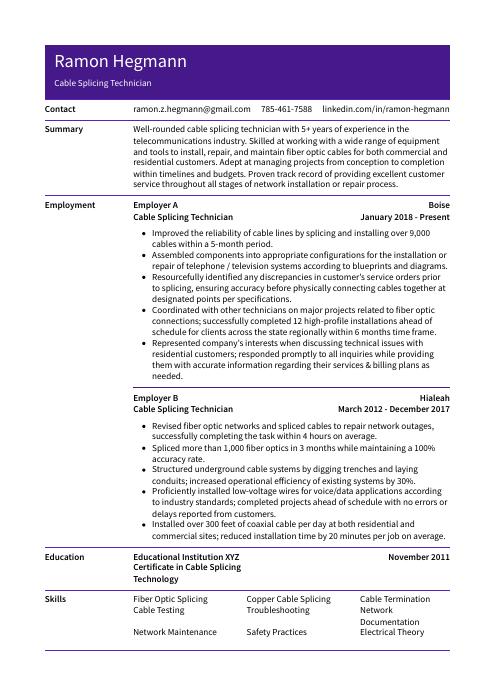 Pika
Pika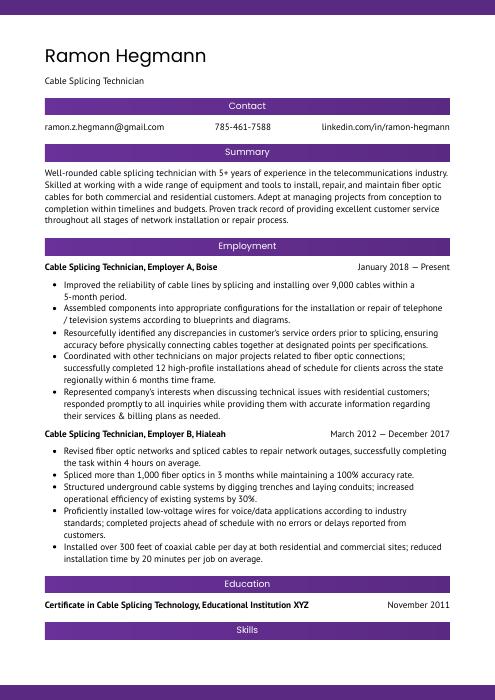 Jerboa
Jerboa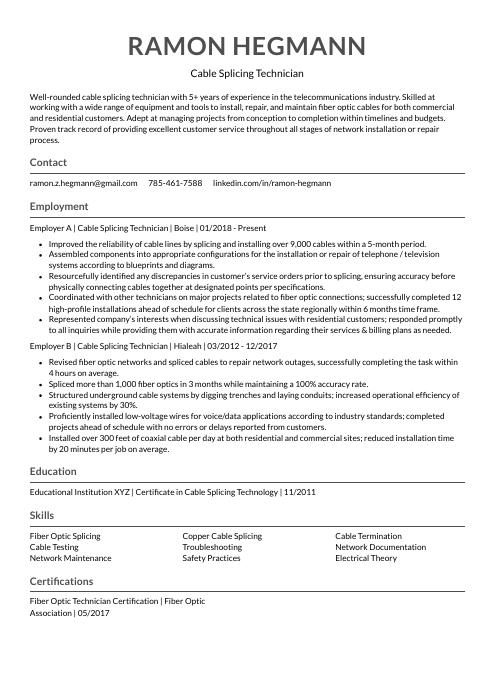 Indri
Indri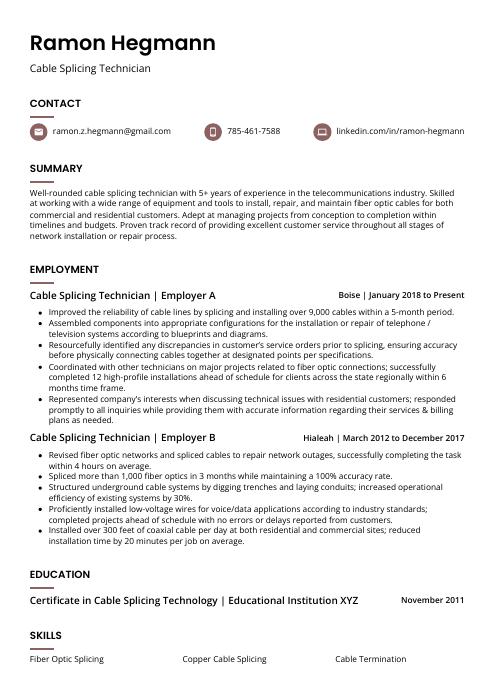 Fossa
Fossa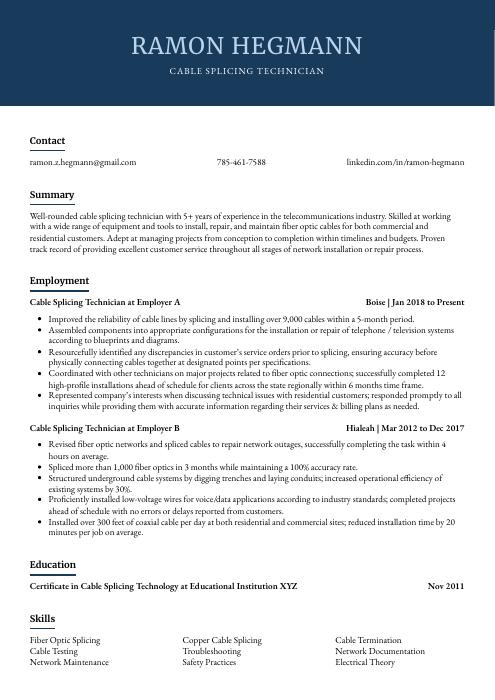 Bonobo
Bonobo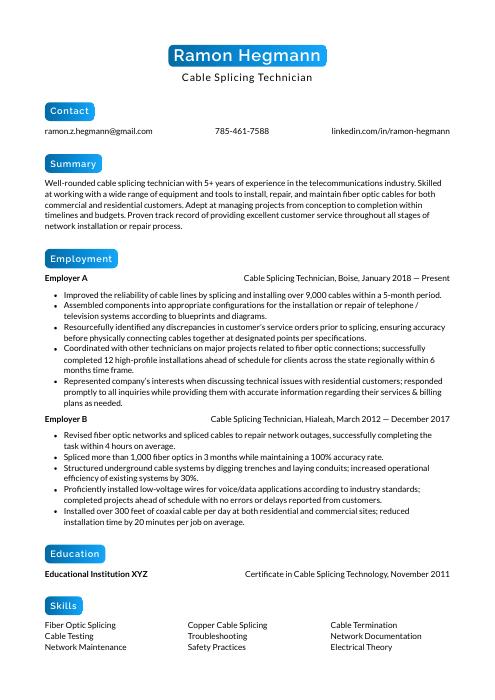 Kinkajou
Kinkajou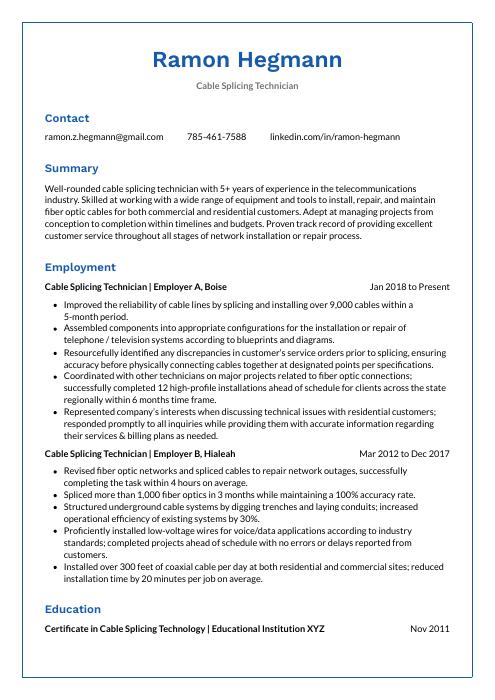 Markhor
Markhor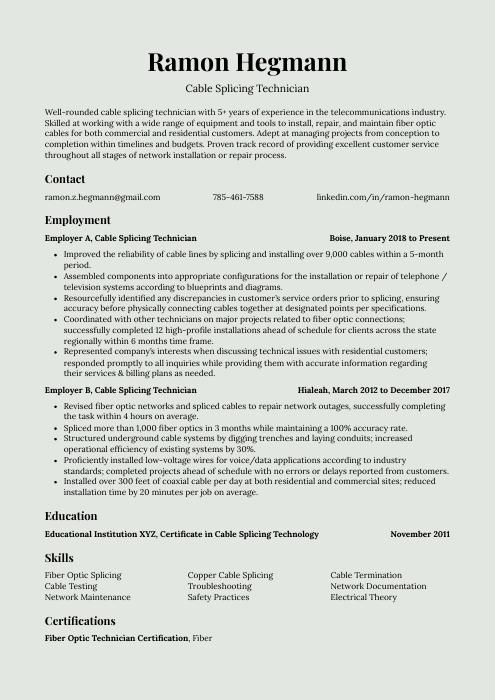 Saola
Saola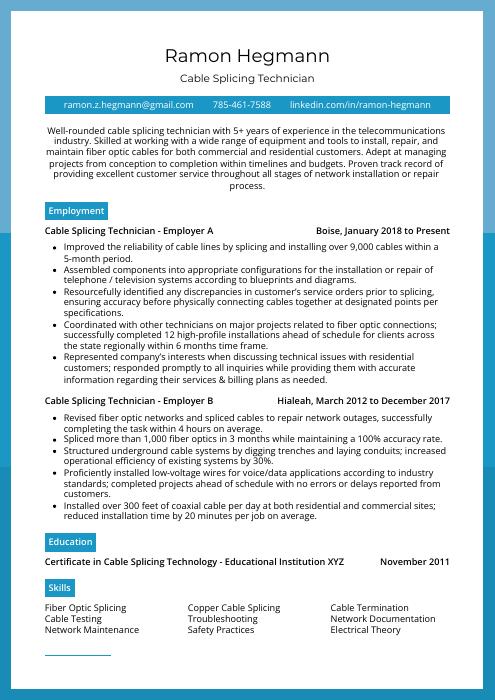 Rhea
Rhea Rezjumei
Rezjumei
